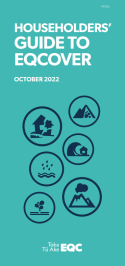Understanding the EQCover Claims Process
After the Canterbury earthquakes in 2010 and 2011, an inquiry into how those claims were handled found that EQC wasn’t prepared for the magnitude of the events. Subsequently, EQC claims are now managed by the insurers.
What is the insurer’s role in EQCover claims?
The insurer is acting on behalf of EQC to assess and settle claims for residential building and/or land damage, in accordance with The Earthquake Commission Act 1993 (the Act).
If you have home insurance, and if your home or land are damaged in a natural disaster, you’ll be able to lodge your claims with your insurer. Your insurer will assess, manage, and settle your claims, including any EQCover claim.
If the damage to your home exceeds your EQCover limit, your insurer will cover the rest of the costs, subject to the terms and conditions of your home insurance policy, and up to your sum insured.
Authority to act on your EQCover claim
If you wish to do so, you can appoint Frank Risk to act on your behalf when communicating with insurers about your EQCover claim.
To appoint Frank, you’ll need to complete an ‘Authority to Act’ form.
Please note that completion of this form is an EQC requirement. It will need to be completed even if you already have an existing Authority to Act, or an existing agreement with Frank Risk.
How will your EQCover claim be settled?
Following the assessment, your insurer and broker will discuss the claim outcome with you, including your entitlement under the Act, your settlement, and excesses.
Understanding your EQCover excess
An excess is the amount you must contribute towards an accepted claim and is deducted from the amount of your settlement.
Your EQCover excess will be discussed with you by your insurer and broker prior to settlement. You can also find out more about EQCover excesses and how they’re calculated at eqc.govt.nz
Understanding your insurer excess
If you have a claim that exceeds your maximum EQCover entitlement, the standard policy excess outlined in your policy schedule will apply as well as the EQCover excess.
If your claim relates to, or includes, property not covered by EQCover (for example paths and driveways), you will be required to pay an insurer natural disaster excess of $5,000 (minimum), as outlined in your policy wording, or the policy excess outlined in your policy schedule – whichever is greater.
Excesses can differ by policy, so check your policy wording and schedule for details of your excess or discuss this with your broker.
What should you do with your payment?
Your cash settlement payment should be used to repair or rebuild the property damaged in the natural disaster.
If you have been paid the cost to repair or rebuild the property, but you don’t, this might affect the amount of cover you have for future damage under your EQCover or under your home insurance policy.
What should you do if you find further damage?
If further natural disaster damage is discovered, you must notify your broker or insurer as soon as possible.
If you discover this damage during the repair process, you must stop all work related to the affected area and contact your broker or insurer immediately for further advice.
If the insurer confirms the newly discovered damage was caused by a natural disaster, you may receive an additional EQCover payment, up to the EQCover limit that applied to your policy at the date of the natural disaster event (subject to terms and limitations determined by EQC, according to the EQC Act).
Where can you find more information?
EQC has produced brochures to help customers understand EQCover for residential land and buildings which can be found below.
Visit eqc.govt.nz for the latest information about EQCover and what you’re insured for, the claim process, settlement and more, or ask your broker to direct you to this information.








